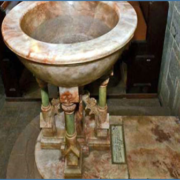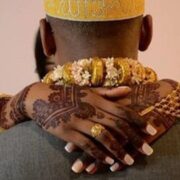
Mr. Wanyama Ogutu is a scholar in the Master of…
Read Next
Once upon a time, I caught a glimpse of a hilarious daily news piece about a church smoking out white clouds of ‘bhang’, marijuana. It was a furiously contested succession race for a certain holy chair. The religious leaders were locked in a closed-door battle over who would succeed the chair. I was interested in attending the religious leader’s inauguration at the same church. It was clear from his facial expression and purple cassock shirt, that the chair accommodates a sense of mythological power and authority. For sure, the chair had attracted the head of state, a delegation of senior government officials, visiting religious leaders, and a contingent of the clergy, among other influential members of society. I watched the designated religious leader relax on a gothic arch-shaped wooden chair around the navel altar.

The chair was designed with lovely patterns of Afrikan floral design. His assistant continued chasing a stray fly on a black tippet and putting on the sleeves of his scarlet chimere gown. The head mitre was swaying up and down, displaying a lovely Afrikan design against a scarlet and white background. His pectoral ring was sparkling with a purple-golden hue, while the pectoral neckless cross was dancing on his big belly on a white rochet. The melody of the hymns thundered on an organ piped so loudly through the wall of the church, accompanied by a shower of claps, and ululation. That was the day I learnt that, contrary to what Achebe once said, an Afrikan man will not piss his trouser when seated on his seat.
The congregation aligned with the Catholic faith always pays allegiance to the chair as they recite the Apostles’ Creed: “He is seated at the right hand of the Father, and He will come to judge the living and the dead.” The Afrikan myth among the Akan and Asante communities adds an claim that the chair was made by gods and then descended from heaven in the wee hours of the night. Among the Abaluhyia-Abukusu of East Africa and the Nok of West Africa, a deceased religious leader was buried while sitting stiffly on a chair. The archeologist discovered that the chair was carved out of dark, indigenous African wood and splashed with the blood of animals sacrificed during shrine ceremonies. It was covered with gold or silver leaf, and some were carved out of precious stone. It was also etched with an Afrikan design inspired by animals, insects, birds, flora, and plants. The chair either took a round or rectangular shape for femininity or a golden rule shape for the male religious leader. It signifies the wealth, ethics, power, and authority of the kingdom. The chair also symbolizes ancestor worship, spiritual authority, and the power of god and goddess.
The chair dominates the enthronement ceremony of a designated archbishop in the Anglican Church. The term “cathedral” is derived from the Latin word “cathedra,” which refers to the chair where a bishop exercises mystagogical power and authority, such as teaching the faith, judging, and appointing clergy. The cathedra is also referred to as “The chair of Apostle Peter” at the Holy Basilica at St. Peter’s Square in Rome and “The Chair of Saint Augustine” at the Cathedral of Canterbury in Kent. For over a century, the chair has taken center stage around the navel altar and the shrine of early churches across the world. It is vital to note that following the split of the Roman Catholic Church in 604 AD, the cathedra became very visible among the Anglo-Saxons who settled in Kent. Consequences: Saint Augustine established a successful evangelical mission of Jesus Christ in Kent, England. Then he became the father of the Anglican Communion.
A cathedra is located on the left side of the navel altar inside the All Saints’ Cathedral in Nairobi. It is a sculpture in the round that was inspired by Gothic furniture featuring Afrikan floral design. It is good to recognize that the floral design is a reflection of the beautiful garden of Aden before God’s judgment on a man, and the geometric shapes reflect the early chair of Saint Augustine. The chair inside All Saints’ Cathedral is elevated on four legs and adjusts to a kneeling wooden floor with a small table. During the Archbishop’s ceremony, the seating surface and the kneeling wooden floor are covered with royal cushions. It is important to note that the analogous royal blue and purple hues correspond to the design of the ceremonial Archbishops’ robe. This is based on the first miracle that Jesus did at the wedding in Cana, according to the gospel of Saint John. The color harmonies of the archbishop’s robes represent water changing into wine. However, the kneeling cushions are not embroidered or printed with any decorative iconography of Christian doctrine.
The sculpture of the chair is characterized by the minimal void and hollow of Gothic arches and rib vaults. Its vertical asymmetrical pattern is balanced by a decorative pattern design on each section side. The back part of the chair takes the shape of an archbishop’s mitre, adorned with explicit floral and geometric shapes. The sitting handle also takes the shape of the pillars in the cathedral-age period. These are evident on the legs of the chair and the handle surface where the elbow and arm rest. The chair was made of “mvuli” wood from the coast of Kenya and sandpapered to give a smooth tactile texture. A closer look reveals that the chair has lasted many centuries. This is due to periodic varnishing to protect the cathedra from natural decomposition and pest attacks.
I’d like to take a moment to point out that the Apostles’ Creed and the myth of Afrikan culture give the impression that the chair has mystagogue power and authority over certain religious leaders.
I appreciate the management’s efforts at All Saints Cathedral, Nairobi, to preserve the chair for mystagogue power and authority in the community at large. The seat will go a long way in preserving the history and memory of Afrikan religion.
REFERENCES
- Brown.(2019). Element of Art & Design And Principle of Design. Retrieved on October 2019.https//www2.oberlin.edu
- Laurie S. A.(1994). A History of Western Art. (5th). New York, MH: McGraw-Hill.
- Marilyn S. & Michael, W.C. (2005). History of Art (4th Ed). London, P: New Jersey.
- Michael. M (2011).Art & Design : Comprehensive Guide For Creative Art. makerere University. Kampla retrieved on October 2010. https://www. aaltodoc.aalto.fi
- Mittler A C. (2006). Art in Focus .Musee national’d Art. Moderne, central George
- Our modern service: All Saints’ Cathedral. ACK Uzima publishing House. Nairobi
- Reeve, M. M. (2003). A Seat of Authority: The Archbishop’s Throne at Canterbury Cathedral. Gesta, 42(2), 131–142. https://doi.org/10.2307/25067082
8. The Living church. From Imperial Symbol to Haven for Justice in Nairobi
. ://livingchurch.org/2022/02/11/from-imperial-symbol-to-haven-for-justice-in-nairobi/
Subscribe now for updates from Msingi Afrika Magazine!
Receive notifications about new issues, products and offers.
What's Your Reaction?
 PIN IT
PIN ITMr. Wanyama Ogutu is a scholar in the Master of Arts (Fine Arts) program at Kenyatta University. He is also a practicing visual artist specializing in drawing, painting, and sculpture within, Nairobi, Kenya. He focusing in Painting with its’ philosophy, education and extension to Africa contemporary Art. Most of his artworks focus on interaction, environment, and education. Wanyama has a passion for fine art research; its philosophy, development, and relevance. He writes on profound academic topics, where he has presented and published in international journals and conferences around the world. He is a consultant in innovation and creative strategy on issues affecting our society. He is currently a part-time teacher at some TVET institutes within Nairobi.

















